Howard B Haas at the summer 2016, See It Big! The 70mm Show at NYC's Museum of the Moving Image | Read more at in70mm.com The 70mm Newsletter |
| Written and photographed by: Howard B. Haas, Philadelphia, USA. All photos by author, except when noted | Date: 03.09.2015 |
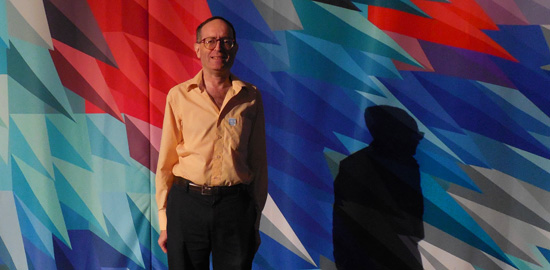 Howard B. Haas, author of this article in front of curtain Howard B. Haas, author of this article in front of curtainBeing a Philadelphia resident, I had never been to the Museum of the Moving Image in the Astoria neighborhood of Queens, New York City, but it was surprisingly easy to get to. From Penn Station in New York, walk to 34th St Herald Square Station, take the N line for about 20 minutes, which is a subway which becomes elevated. Exit at 36th Ave Station, and the museum is a few blocks away. From the elevated, many factories and warehouses are visible, some of which have been converted to other uses. In the 1920s, before Hollywood became moviemaking central, Famous Players-Lasky, which became Paramount in 1927, built thirteen buildings as film studios in Astoria. The buildings were taken over by the US Army in 1942 to produce training films. After the Army departed in 1970, a local foundation took over the buildings to return them to use for film production use. In 1980, local developer George Kaufman was selected to manage the buildings and the complex was renamed Kaufman Astoria Studios. | More in 70mm reading: "SEE IT BIG!" 70MM Series @ Museum of the Moving Image, New York, USA 7OMM Festival in New York, USA "SEE IT BIG!" 70MM Series @ Museum of the Moving Image, New York, USA The Ziegfeld has closed Seattle Cinerama 70mm Film Festival 2013 "Interstellar" in 70MM at the Ziegfeld in New York Internet link: |
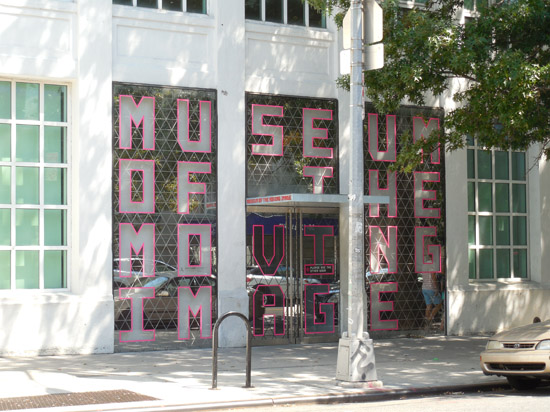 Entry to Museum of Moving Image Entry to Museum of Moving ImageOne of the thirteen buildings was opened September 10, 1988, by the foundation which renamed itself The Museum of the Moving Image. This was the first museum in the United States devoted specifically to the history of moviemaking and television. Days later that same year, the National Museum of Photography, Film and Television opened in Bradford, England. In 2010, I visited the Bradford museum and saw “This is Cinerama” in the Pictureville auditorium there. The Museum of the Moving Image has a “Core Exhibition” which consists of various sections over two levels including Makeup. Scenery Artists. Costume Design. Sound. Lighting. Editing. Special Effects. Screenwriting. There are also sections of equipment: cameras and projectors for movies and cameras for television and vintage television sets. There are no 70mm cameras or projectors on display in the Core Exhibition, but there are items in the movie making exhibition. Prosthetic for an ape mask, hand and foot from “2OO1: A Space Odyssey” a Elizabeth Taylor wig from “Cleopatra” and a giant billboard from “Exodus” are on display. When I visited, there was also a temporary display from March 4, 2016 to October 9, 2016 “To the Moon and Beyond: Graphic Films and the Inception of 2001: A Space Odyssey” mostly consisting of sketches created by Graphic Films to assist in the design of that movie. | |
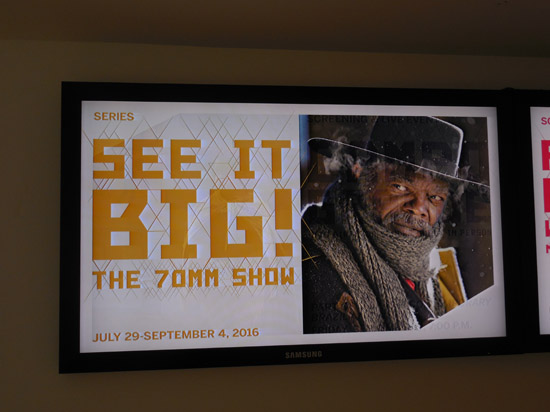 Lobby electronic sign Lobby electronic signIn 2011, the original building was expanded with a new 262 seat, stadium seated auditorium equipped for various film formats including 70mm, and a large 33.5 x 18 foot screen. The auditorium is named the Sumner Redstone Auditorium, a historically fitting name for the site since Redstone owns the National Amusements movie theater chain, CBS television, and Paramount Studios. The architecture of the Museum of the Moving Image is visually primarily a museum, not a movie theater. So outside there is no marquee featuring movie titles. Inside, there's a museum reception desk rather than a movie box office. There isn't much in the way of movie poster display cases or graphics, but there is an electronic billboard opposite the Coat check, so movie series are featured there. In prior years, the Museum of the Moving Image screened many 70mm films but this year was the first I attended. The first of this year's screenings of 70mm movies that I attended along with 80 other people was Khartoum (1966, 128 minutes) on Saturday August 6 at 3 PM. A near perfect looking 2008 print was provided by Park Circus and shown in proper Ultra Panavision 70 aspect ratio of 2.76. I had seen the print at the AFI Silver in the burbs of Washington D.C. in 2012, and enjoyed it this second time. The curtain was closed before the film and used again during intermission and at the end. I enjoyed the outstanding overture music, intermission music and music at the end. | |
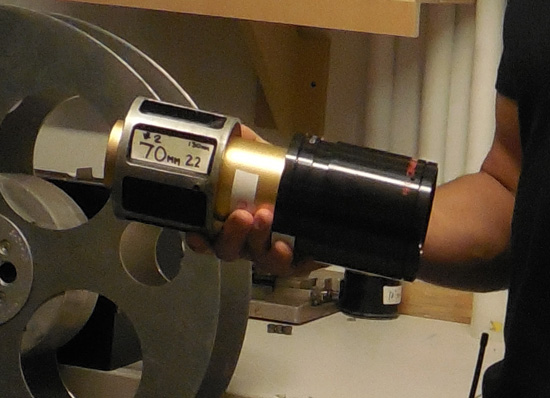 Chief Projectionist Fred Baez holding Ultra Panavision 70 anamorphic lens Chief Projectionist Fred Baez holding Ultra Panavision 70 anamorphic lensThe next film I attended was The Wild Bunch (1969, 145 minutes) on Saturday August 13 at 2 PM. I had seen the movie only once before, a fine 35mm print of the Director's Cut during the Warner Brothers 75th anniversary festival, on the huge screen of the Uptown in Washington D.C. At the museum, this was a 35mm blowup to 70mm, with 2.2 aspect ratio. I heard a bit of surround sound at the final battle scene. There was some static in the sound, so I knew it was a print with sound on the film rather than digitally restored sound. The print from Warner Bros. Classics was good, though not perfect, and likely was a print from the 1995 restoration. The curtain was properly used before and after the film. 152 attended Saturday's screening, and I was told by museum staff that 200 attended the next day's screening. | |
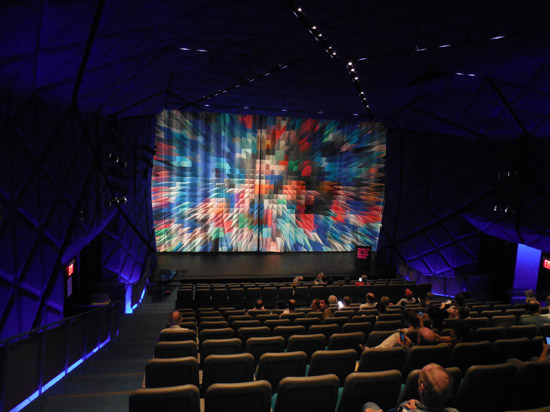 The last film I attended was STAR! (1968, 175 min) on Saturday August 27 at 3 PM. 20th Century Fox provided the pristine 70mm print from 2008, 2.2 aspect ratio, with digital sound. The curtain was again properly used including during Intermission. This movie's overture music actually is with an opening scene, and there didn't appear to be Intermission music. I had not seen this movie before, and was delighted. The movie looked gorgeous on the big screen and deserved its Oscar nominations for Cinematography, Color Costume Design, Art Direction, Score for Musical, Original Song, Sound Mixing, and Supporting Actor. There was much surround sound. 128 attended. Last year, I saw in a Philadelphia suburban movie theater a DCP screening of “Mary Poppins” (1964) which also starred Julie Andrews. In addition to having seen twice in 70mm “The Sound of Music” (1965), I saw Julie Andrews in person when she appeared in 2008 at a book signing for her autobiography at Macys in the John Wanamaker Building in Philadelphia. The last film I attended was STAR! (1968, 175 min) on Saturday August 27 at 3 PM. 20th Century Fox provided the pristine 70mm print from 2008, 2.2 aspect ratio, with digital sound. The curtain was again properly used including during Intermission. This movie's overture music actually is with an opening scene, and there didn't appear to be Intermission music. I had not seen this movie before, and was delighted. The movie looked gorgeous on the big screen and deserved its Oscar nominations for Cinematography, Color Costume Design, Art Direction, Score for Musical, Original Song, Sound Mixing, and Supporting Actor. There was much surround sound. 128 attended. Last year, I saw in a Philadelphia suburban movie theater a DCP screening of “Mary Poppins” (1964) which also starred Julie Andrews. In addition to having seen twice in 70mm “The Sound of Music” (1965), I saw Julie Andrews in person when she appeared in 2008 at a book signing for her autobiography at Macys in the John Wanamaker Building in Philadelphia. | |
From the History Book, 1968 | |
 STAR! at its The star studded Philadelphia 1st run premiere. Photo: Dennis Zimmerman STAR! at its The star studded Philadelphia 1st run premiere. Photo: Dennis ZimmermanI had been previously familiar with STAR! because since 2002 as a volunteer, I've led the efforts of our nonprofit Friends of the Boyd to save what was Philadelphia's last surviving movie palace, the Boyd and have researched the Boyd's history. Last year, the auditorium was unfortunately lost, after three separate viable proposals to save it didn't happen. The Boyd's “Cinerama” marquee dating from 1953 is to survive. STAR! had a gala benefit at the Boyd on November 6, 1968 for the Philadelphia Museum of Art with director Robert Wise and other celebrities appearing, and newspaper photos of that Philadelphia premiere show spotlights and limousines on Chestnut Street in front of the Boyd. The 70mm roadshow with reserved seats was shown until February 11, 1969. In addition to the newspapers, one of our supporters also photographed the Boyd marquee with STAR! Dennis Zimmerman was a devoted moviegoer, including 70mm roadshows, and shared with me his photos of Philadelphia and Manhattan movie palaces so I could in turn share them on the Internet, which I did at cinematreasures.org Dennis passed away in 2014, but I know he would have been delighted with the wonderful, correct presentations of classic 70mm films at the Museum of the Moving Image. | |
More Pictures | |
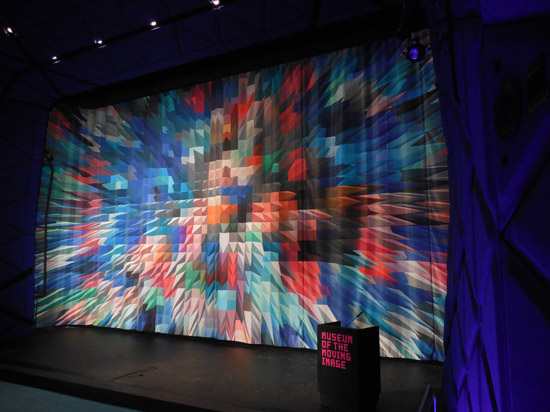 | |
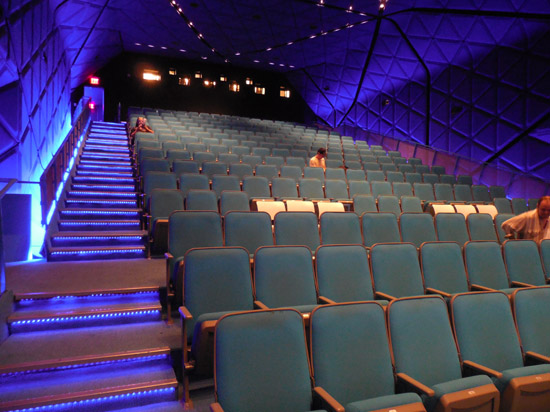 | |
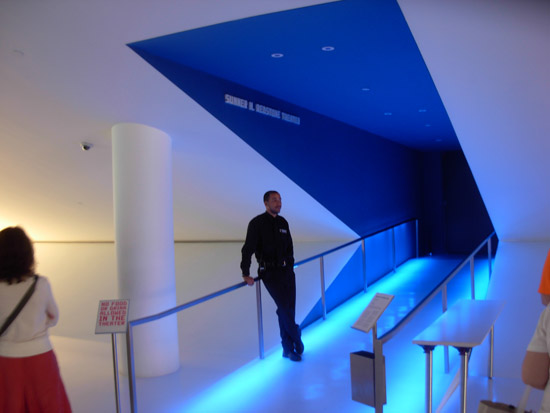 | |
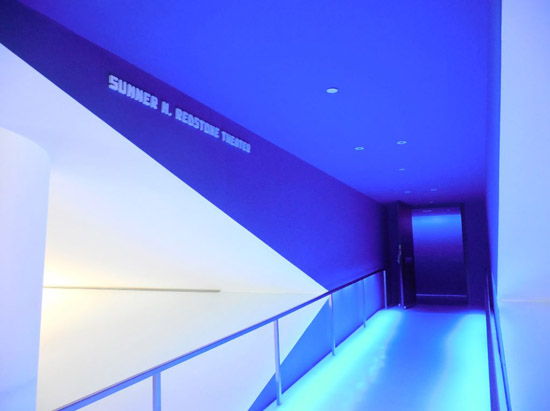 | |
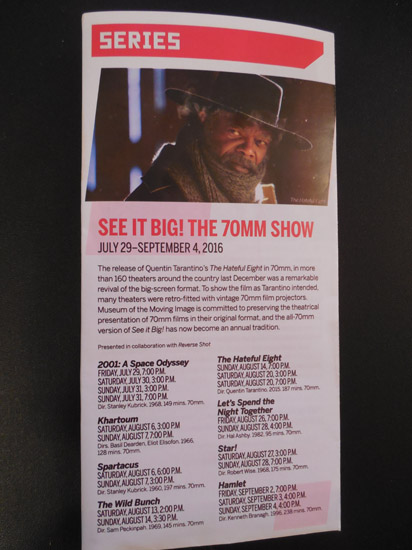 Film Brochure Film Brochure | |
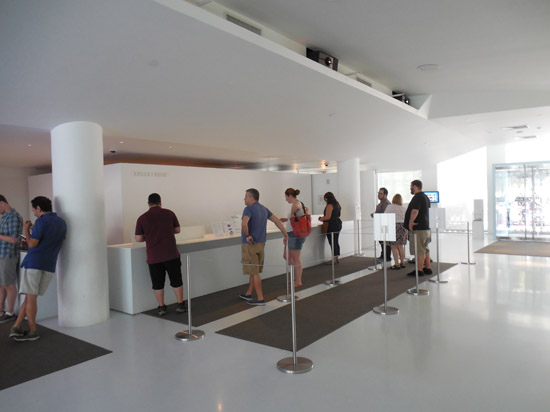 Museum desk with customers for STAR! Museum desk with customers for STAR! | |
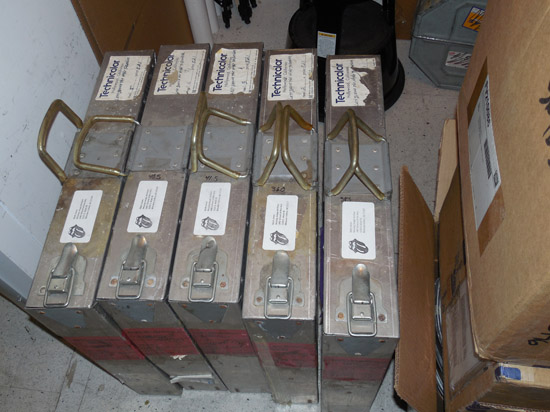 70mm reels of Let's Spend the Night Together 70mm reels of Let's Spend the Night Together(STAR! arrived in cardboard boxes!) | |
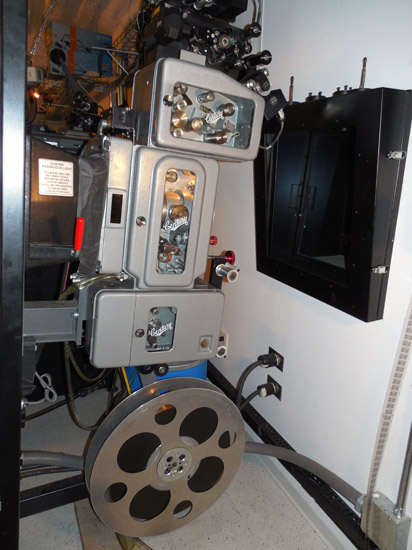 Century 70 mm film projector with doors closed and a reel of 70mm film below of "Let's Spend the Night Together" Century 70 mm film projector with doors closed and a reel of 70mm film below of "Let's Spend the Night Together" | |
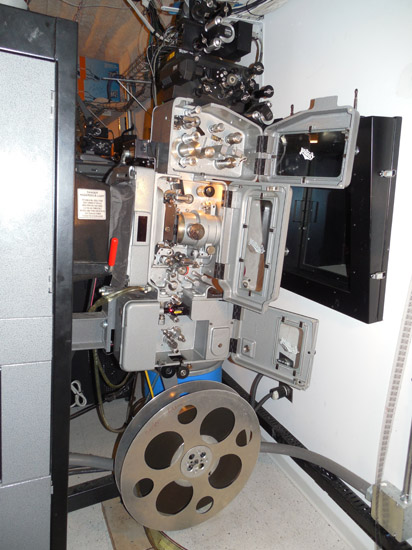 Century 70 mm film projector with doors open and a reel of 70mm film below of "Let's Spend the Night Together" Century 70 mm film projector with doors open and a reel of 70mm film below of "Let's Spend the Night Together" | |
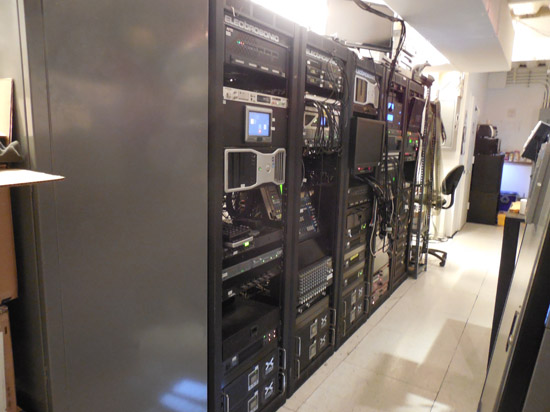 Sound Racks Sound Racks | |
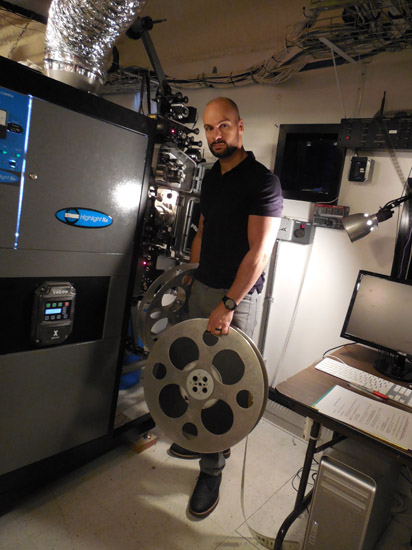 Chief Projectionist Fred Baez holding reel of 70 mm film of "Let's Spend the Night Together" Chief Projectionist Fred Baez holding reel of 70 mm film of "Let's Spend the Night Together" | |
| Go: back - top - back issues - news index Updated 07-08-24 |
